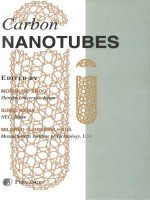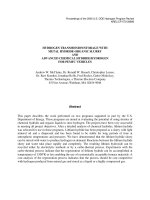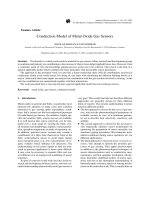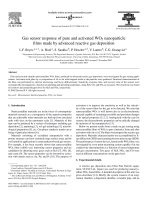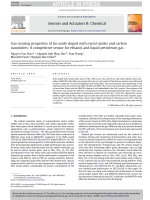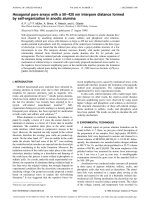- Trang chủ >>
- Khoa Học Tự Nhiên >>
- Vật lý
novel hexagonal wo3 nanopowder with metal decorated carbon nanotubes as no2 gas sensor
Bạn đang xem bản rút gọn của tài liệu. Xem và tải ngay bản đầy đủ của tài liệu tại đây (523.55 KB, 5 trang )
A
vailable online at www.sciencedirect.com
Sensors and Actuators B 133 (2008) 151–155
Novel hexagonal WO
3
nanopowder with metal decorated carbon
nanotubes as NO
2
gas sensor
Csaba Bal
´
azsi
a,∗
, Katar
´
ına Sedl
´
ackov
´
a
a
, Eduard Llobet
b
, Radu Ionescu
b
a
Research Institute for Technical Physics and Materials Science, Hungarian Academy of Sciences, Konkoly-Thege M. ´ut 29-33,
1121 Budapest, Hungary
b
MINOS, Department d’Enginyeria Electronica, Universitat Rovira i Virgili, Av. Pad’sos Catalans 26, 43007 Tarragona, Spain
Received 9 November 2007; received in revised form 4 February 2008; accepted 5 February 2008
Available online 12 February 2008
Abstract
In this work, hexagonal tungsten oxide (hex-WO
3
) nanopowders were prepared by acidic precipitation from a sodium tungstate solution. TEM
analysis of nanopowders showed that the average size of the hexagonal nanoparticles was 50–100 nm. Novel hybrid composites were fabricated
by embedding a low amount of carbon nanotubes into the hex-WO
3
matrix. Metallic nanoclusters (Ag, Au) were added to the carbon nanotubes
for improving the gas sensing properties of the films. The addition of MWCNTs lowered the temperature range of sensitivity of the hex-WO
3
nanocomposites to NO
2
hazardous gas. In comparison, the sensitivity of hex-WO
3
to NO
2
was in the temperature range between 150
◦
C and 250
◦
C,
while the hex-WO
3
/MWCNTs composites were sensitive to NO
2
gas at room temperature.
© 2008 Elsevier B.V. All rights reserved.
Keywords: Hexagonal WO
3
; Carbon nanotube; Sensing properties; TEM
1. Introduction
Detection of hazardous gases, e.g. NO
2
which results from
combustion and automotive emissions [1], is very important for
the environmental protection and human health. The adsorp-
tion of gases basically occurs at the surface level of a sensing
film, and an increase in the active surface area of the semi-
conductor oxide would enhance the properties of the materials
used for gas sensors. The mechanism of the electrical conduc-
tivity change of the oxide under gas exposure is understood in
terms of adsorption–desorption reactions involving surface oxy-
gen vacancies [2]. Among of other candidates, tungsten oxides
have been commonly applied as sensing layers for hazardous
gas detection [3,4]. Various crystalline forms of tungsten oxides
can be prepared by thermal evaporation of WO
3
powder [5,6],
by radio-frequency-sputtering from metallic W [7] or WO
3
tar-
gets [8] in an Ar/O
2
atmosphere, by chemical vapor deposition
[9] and by wet chemistry such as the sol–gel process [10].
∗
Corresponding author.
E-mail address: (C. Bal
´
azsi).
In the present work, acidic precipitation is carried out by a
nanocrystalline processing route; the preparation of nanocrys-
talline hexagonal WO
3
is demonstrated. Multi-walled carbon
nanotubes (MWCNTs) wereaddedto hexagonal WO
3
nanopow-
der with the aim to further lower the operating temperature of
sensors [11]. The carbon nanotubes were decorated with metal-
lic nanoclusters (Au and Ag) in order to obtain an improved
sensitivity to NO
2
at room temperature [12]. The gas sens-
ing properties of the hex-WO
3
and hybrid hex-WO
3
/MWCNTs
composites were tested in the presence of very low concentra-
tions of NO
2
(nitrogen dioxide).
2. Experimental
2.1. Preparation of hexagonal WO
3
nanopowder
Tungstic acid samples were prepared by acidic precipitation
from sodium tungstate solution according to Zocher method
[13]. 10.5 g Na
2
WO
4
·2H
2
O was dissolved in water and a
hydrochloric acid solution 18% in excess of equimolar reac-
tion was added to this at a reaction temperature not higher than
5
◦
C. The resulted centrifuged H
2
WO
4
·H
2
O precipitates were
dispersed in water again and were passed to high-temperature
0925-4005/$ – see front matter © 2008 Elsevier B.V. All rights reserved.
doi:10.1016/j.snb.2008.02.006
152 C. Bal´azsi et al. / Sensors and Actuators B 133 (2008) 151–155
Fig. 1. TEM images of WO
3
nanopowder. (a) Orthorhombic WO
3
1/3H
2
O “mother” phase, and (b) hexagonal WO
3
phase.
treatment in an autoclave at 125 ± 5
◦
C. The resulted powder was
dried in a desiccator, and after that was heat treated (anneal-
ing at ∼330
◦
C for 90 min in ambient air). The details of the
preparation are described in our previous papers [14,15].
2.2. Metal decoration of the carbon nanotubes
The MWCNTs were obtained from Mercorp [16]. They were
prepared by arc discharge without use of catalysts. The MWC-
NTs powder presents 99% of carbon with 30–40% nanotube
content. Subsequently, the nanotubes were modified with Au or
Ag nanoclusters by thermally evaporating gold or silver atoms
onto the MWCNTs surface from a gold or silver wire, respec-
tively [17].
2.3. Sensors fabrication
A drop coating method was employed for depositing the sens-
ing materials onto silicon based microhotplates. Full details on
these sensor substrates can be found in paper [18]. To prepare
the deposition paste, MWCNTs decorated with the metallic nan-
oclusters were dissolved in glycerol (700 mg in 1 ml), and then
a precise amount of hex-WO
3
nanopowder was added in order
to obtain the desired proportions of CNT/WO
3
(i.e. 1/250 and
1/500 wt% for Ag- and Au-decorated CNTs, respectively). The
mass ratios selected were based on previous studies [11,19,20].
The dispersion and adequate mixture of the components were
enhanced by stirring the solution in an ultrasonic bath for 2 h at
75
◦
C. The resulting paste was then dropped onto the microma-
chined silicon membranes by using a microinjector (JBE1113
Dispenser, I&J FISNAR Inc., USA). The deposited films were
dried at 170
◦
C for 1 h in order to burn out the organic vehicle,
and finally annealed at 400
◦
C for 2 h. This process was car-
ried out in air, and it ensured a good adherence of the deposited
materials to the sensor substrates.
2.4. Experimental techniques
The structural characterizations of the samples were inves-
tigated by transmission electron microscopy (TEM). TEM
analysis and selected area electron diffraction (SAED) were
carried out on a Philips CM-20 microscope operating at 200 kV.
The gas sensing properties of the hybrid composite films were
tested in the presence of very low concentrations of NO
2
.To
perform the measurements, the gas sensors were placed inside
a 5.3 dm
3
test chamber, and the desired concentrations of NO
2
(ranging from 100 ppb to 1 ppm) were introduced by the direct
injection method using a gas-tight chromatographic syringe. A
fan was employed to provide the homogeneity of gas diffusion
inside the test chamber. After each series of successive injec-
tions, the sensor chamber was flushed using pure dry air for
2 h, which ensured the cleaning of both the chamber and the
sensor surface. During this process, the sensors were heated at
250
◦
C in order to speed up gas desorption. An Agilent 34970A
multimeter was used for continuously monitoring the electrical
resistance of the sensors during the measurement process. The
data acquired were stored in a PC for further analysis.
3. Results and discussion
3.1. Structural properties of WO
3
nanopowder
The TEM analysis of tungsten oxide powders prepared from
the Zocher type tungstic acid gel confirmed the change in the
phases. In Fig. 1a is shown the structure of WO
3
1/3 H
2
O
“mother” phase as obtained after hydrothermal preparation. The
selected area electron diffraction (SAED) of nanopowder shows
the orthorhombic phase of WO
3
1/3 H
2
O crystallites. The aver-
age size of WO
3
1/3 H
2
O crystallites is ∼80–100 nm.
A dehydration process (WO
3
1/3 H
2
OtoWO
3
) was tak-
ing place during calcination of powders (at 330
◦
C, 90 min, air).
This dehydration was accompanied by a structural change; from
orthorhombic WO
3
1/3H
2
O hex-WO
3
was obtained. The elec-
tron diffraction of heat treated sample confirmed the hexagonal
phase of WO
3
(Fig. 1b). From TEM analysis, the crystalline
derivative consists of aggregates (∼500 nm) of rods and the
average size of hex-WO
3
crystallites is ∼50–100 nm.
3.2. Structural properties of WO
3
/MWCNTs
The TEM images recorded on the novel hex-WO
3
/metal
decorated MWCNTs composites (Figs. 2 and 3, for MWC-
NTs decorated with Ag and Au nanoparticles, respectively)
show a fair good dispersion of both materials. This achieve-
C. Bal´azsi et al. / Sensors and Actuators B 133 (2008) 151–155 153
Fig. 2. TEM images of hexagonal WO
3
with Ag decorated MWCNTs. (a) TEM image of hexagonal WO
3
nanograins and MWCNTs, and (b) detail of Ag decorated
carbon nanotubes.
ment allows for envisaging the possibility of these new hybrid
material composites to combine the sensing properties of the two
components.
3.3. Gas sensing properties
At first, the gas sensing properties of hex-WO
3
were inves-
tigated. Fig. 4a shows the response of a hex-WO
3
sensor to
increasing concentration of NO
2
. This result was recorded for
the sensor operated at 250
◦
C. When the operating temperature
was lowered below 250
◦
C (in this paper not shown), the con-
ductivity change drastically decreased (more than a factor of
four at 150
◦
C, while at room temperature it lose completely
its property to sense NO
2
in the concentration range up to
1 ppm).
In the next step, the sensing characteristics of the novel com-
posite materials were also studied. Fig. 4b shows the response
of a hex-WO
3
/Au-decorated MWCNTs sensor to increasing
concentration of NO
2
. This response, recorded for the sensor
operated at room temperature, demonstrates that the addition of
a small amount of MWCNTs to the original hex-WO
3
matrix
can improve the sensing potential in terms of room temperature
NO
2
detection. On the other hand, no response was obtained by
these sensors operated at higher temperatures up to 250
◦
C.
Importantly, the quantity of MWCNTs embedded into the
hex-WO
3
matrix plays a crucial role, and it depends on the
type of metal used to decorate the carbon nanotubes. Thus, the
optimal weight ratio was found to be 1:250 in the case of Ag-
decorated MWCNTs (not shown) and 1:500 for Au-decorated
MWCNTs (Fig. 4b), respectively. Other weight ratios made the
hybrid materials to loose their property to sense NO
2
at room
temperature.
The addition of carbon nanotubes to hex-WO
3
modifies fur-
thermore the semiconducting characteristics of the active layer
of sensors. While hex-WO
3
is an n-type semiconductor, the
hybrid hex-WO
3
/MWCNTs behaves as a p-type material (simi-
larly to the carbon nanotubes), as its resistance decreases under
NO
2
(i.e., oxidizing gas) exposure (see Fig. 4b).
Fig. 3. TEM images of hexagonal WO
3
with Au decorated MWCNTs. (a) TEM image of hexagonal WO
3
nanograins and MWCNTs, and (b) detail of Au decorated
carbon nanotubes.
154 C. Bal´azsi et al. / Sensors and Actuators B 133 (2008) 151–155
Fig. 4. Resistance change experienced by the gas sensors exposed to increasing concentrations of NO
2
. (a) h-WO
3
film operated at 250
◦
C, and (b) Au-MWCNTs/hex-
WO
3
(1/500 wt%) film operated at room temperature.
4. Conclusion
Hexagonal tungsten oxide nanopowders were successfully
prepared by acidic precipitation from a sodium tungstate solu-
tion. TEM analysis of nanopowders showed that the average
size of hexagonal nanoparticles was 50–100 nm. Chemical gas
sensors based on hex-WO
3
operating at 250
◦
C showed a good
potential to detect very low amounts of NO
2
, but they sig-
nificantly lose this sensing characteristic at lower operating
temperatures, while at room temperature they could not detect
NO
2
at all.
The elaboration of a new gas sensitive composite materials
technology was afterwards reported. A new approach was intro-
duced when room temperatures detection of hazardous gases
was desired, consisting in embedding a low amount of metal
decorated (Ag, Au) carbon nanotubes into the hex-WO
3
matrix.
Indeed, the new fabricated hybrid material composites were able
to detect as low as 100 ppb of NO
2
, with no need to heat the
sensor substrates during operation.
Thus, the main achievement that we report in our work is
the creation of active films sensitive to NO
2
at low operating
temperatures. The detected concentration level is very close to
the ambient air quality standard for nitrogen dioxide established
by the Department of Environment and Natural Resources, USA
(i.e. 53 ppb [21]), which demonstrates the high potential of our
new gas sensors.
Acknowledgements
The work was supported by the bilateral NSF-OTKA-MTA
co-operation, contract no. MTA: 96 OTKA: 049953. R. Ionescu
acknowledges a ‘Juan de la Cierva’ research fellowship funded
by the Spanish Ministry for Science and Education. The authors
are grateful to A. Felten and J.J. Pireaux from Falcult
´
es Univer-
sitaires Notre Dame de la Paix, Namur, Belgium, for providing
us the metal decorated carbon nanotubes.
References
[1] G. Eranna, B.C. Joshi, D.P. Runthala, R.P. Gupta, Oxide materials for devel-
opment of integrated gas sensors–a comprehensive review, Crit. Rev. Solid
State Mater. Sci. 29 (2004) 111–188.
[2] M. Gillet, R. Delamare, E. Gillet, Growth, structure and electri-
cal conduction of WO
3
nanorods, Appl. Surf. Sci. 254 (2007) 270–
273.
[3] M. Stankova, X. Vilanova, E. Llobet, J. Calderer, C. Bittencourt, J.J.
Pireaux, X. Correig, Influence of the annealing and operating tempera-
tures on the gas-sensing properties of rf sputtered WO
3
thin-film sensors,
Sens. Actuators B Chem. 105 (2005) 271–277.
[4] Y.G. Choi, G. Sakai, K. Shimanoe, N. Yamazoe, Wet process-based fabri-
cation of WO
3
thin film for NO
2
detection, Sens. Actuators B Chem. 101
(2004) 107–111.
[5] A. Al Mohammed, M. Gillet, Phase transformations in WO
3
thin films during annealing, Thin Solid Films 408 (2002) 302–
309.
[6] M. Akiyama, Z. Zhang, J. Tamaki, N. Miura, N. Yamazoe, T. Harada, Tung-
sten oxide based semiconductor sensor for detection of nitrogen oxides
in combustion exhaust, Sens. Actuators B Chem. 13–14 (1993) 619–
620.
[7] Z. Xu, J.F. Vetelino, R. Lee, D.C. Parker, Electrical properties of
tungsten trioxide films, J. Vac. Sci. Technol. A8 (1990) 3434–
3438.
[8] H. Kaneko, S. Nishimoto, K. Miyake, N. Suedomi, Physical and electro-
chemichromic properties of RF sputtered tungsten oxide films, J. Appl.
Phys. 59 (1986) 2526–2534.
[9] S. Pal, C. Jacob, The influence of substrate temperature variation on tung-
sten oxide thin film growth in an HFCVD system, Appl. Surf. Sci. 253
(2007) 3317–3325.
[10] J. Shieh, H.M. Feng, M.H. Hon, H.Y. Juang, WO
3
and W–Ti–O thin-film
gas sensors prepared by sol–gel dip-coating, Sens. Actuators B Chem. 86
(2002) 75–80.
[11] E.H. Espinosa, R. Ionescu, B. Chambon, G. Bedis, E. Sotter, C. Bittencourt,
A. Felten, J J. Pireaux, X. Correig, E. Llobet, Hybrid metal oxide and
multiwall carbon nanotube films for low temperature gas sensing, Sens.
Actuators B Chem. 127 (2007) 137–142.
[12] E.H. Espinosa, R. Ionescu, C. Bittencourt, A. Felten, R. Erni, G. Vantende-
loo, J J. Pireaux, E. Llobet, Metal-decorated multi-wall carbon nanotubes
for low temperature gas sensing, Thin Solid Films 515 (2007) 8322–
8327.
[13] M. Yoshimura, W.L. Suchanek, K. Byrappa, Soft solution processing: a
strategy for one-step processing of advanced inorganic materials, MRS
Bull. 25 (9) (2000) 17–25.
[14] Cs. Balazsi, J. Pfeifer, Structure and morphology changes caused by wash
treatment of tungstic acid precipitates, Solid State Ionics 124 (1999) 73–
81.
[15] Cs. Balazsi, in: R. Kuzel, J. Fiala, Z. Weiss (Eds.), Materials Structure,
Bulletin of the Czech and Slovak Crystallographic Association, vol. 6, no.
2, 1999, pp. 135– 139, Prague.
[16] .
[17] A. Felten, C. Bittencourt, J F. Colomer, G. Van Tendeloo, J J. Pireaux,
Nucleation of metal clusters on plasma treated multi wall carbon nanotubes,
Carbon 45 (2007) 110–116.
C. Bal´azsi et al. / Sensors and Actuators B 133 (2008) 151–155 155
[18] D.G. Rickerby, N. W
¨
atchter, M.C. Horrillo, J. Guti
´
errez, I. Garcia, C. Can
´
e,
Structural and dimensional control in micromachined integrated solid state
gas sensors, Sens. Actuators B 69 (2000) 314–319.
[19] C. Bittencourt, A. Felten, E.H. Espinosa, R. Ionescu, E. Llobet, X. Correig,
J J. Pireaux, WO
3
films modified with functionalized multi-wall carbon
nanotubes: morphological, compositional and gas response studies, Sens.
Actuators B 115 (2006) 33–41.
[20] R. Ionescu, E.H. Espinosa, R. Leghrib, A. Felten, J.J. Pireaux, R. Erni,
G. Van Tendeloo, C. Bittencourt, N. Canellas, E. Llobet, Novel hybrid
materials for gas sensing applications made of metal-decorated MWCNTs
dispersed on nano-particle metal oxides, Sens. Actuators B 131 (2008)
174–182.
[21] />Biographies
Csaba Bal
´
azsi received his PhD in 2000 from the University Miskolc, Hun-
gary. He is currently Head of the Ceramics and Nanocomposites Department
at Research Institute for Technical Physics and Materials Science, Budapest,
Hungary. His work focuses on the ceramic nanocomposites, mainly on ceramic
nanocomposites for high temperature (Si
3
N
4
/CNT), sensor (hex-WO
3
) and bio-
applications (hydroxyapatite).
Katar
´
ına Sedl
´
ackov
´
a graduated as material engineer from the Slovak Technical
University, Bratislava in 2000. She received her PhD in 2002 from the same
university. She is currently deputy head of the Thin Film Physics Department
at Research Institute for Technical Physics and Materials Science, Budapest,
Hungary. Her main areas of interest are the carbon based nanocomposites and
their structural characterization by transmission electron microscopy.
Eduard Llobet graduated in telecommunication engineering from the Univer-
sitat Polit
`
ecnica de Catalunya (UPC), Barcelona, Spain in 1991, and received
his PhD in 1997 from the same University. He is an associate professor of elec-
tronics at the University Rovira i Virgili (Tarragona, Spain). His main research
interests are in the fabrication and modelling of semiconductor gas sensors and
in the applications of intelligent systems to complex odour analysis.
Radu Ionescu is a postdoctoral research fellow at the Department of Electronics,
Electrical and Automatic Engineering, Rovira i Virgili University, Tarragona,
Spain. His main research interests are in the field of chemical gas sensors, carbon
nanotubes and pattern recognition.

